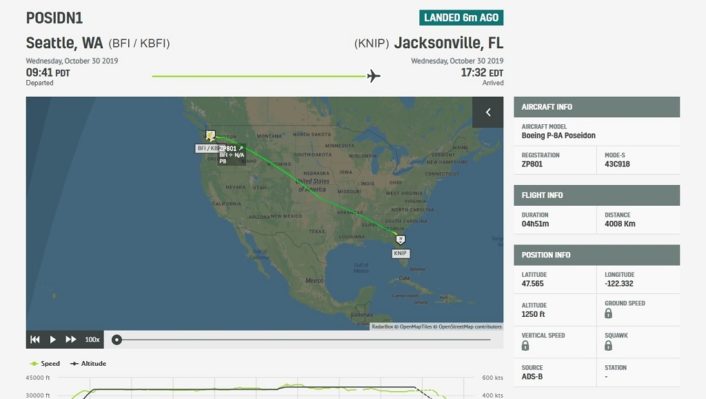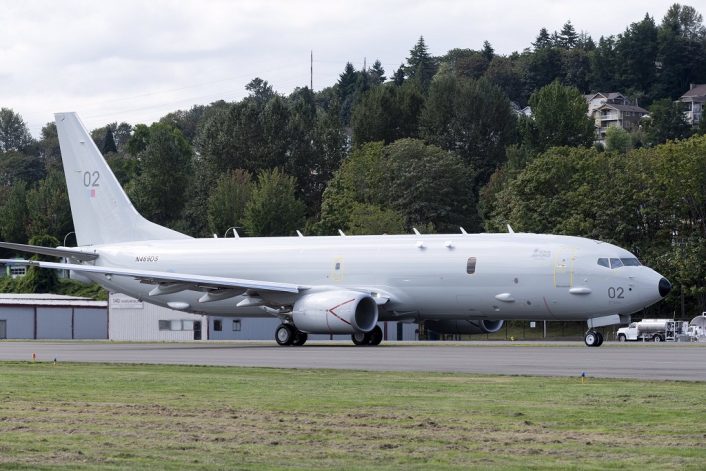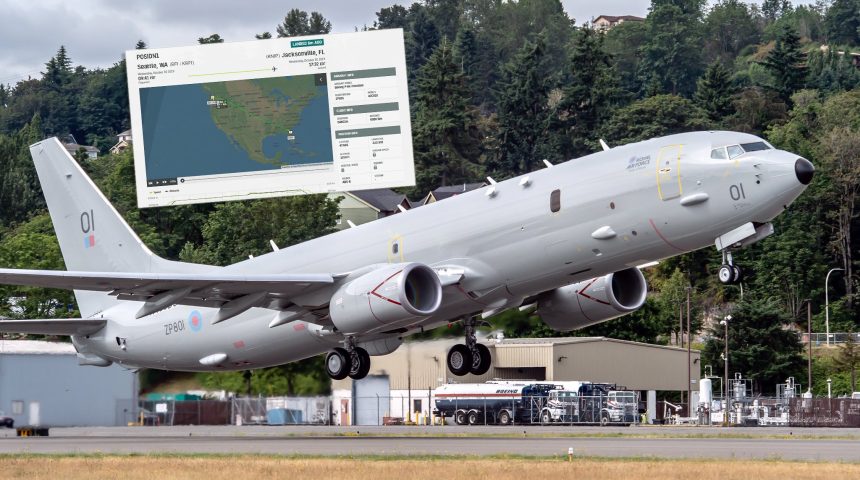The aircraft will stay at NAS Jacksonville until next year.
The Royal Air Force took delivery of the first P-8 Maritime Patrol Aircraft during a ceremony at the Boeing plant in Seattle on Oct. 29, 2019. The aircraft, that in the British service is designated Poseidon MRA Mk.1 (Maritime, Reconnaissance, Attack) was formally handed over the next day, after a delivery flight to Naval Air Station Jacksonville, where it will be based until next year.
Air Marshal Turner, DCOM Capability for @RoyalAirForce receives the “keys” of our first @P8A_PoseidonRAF. Thank you @BoeingDefense @BoeingUK for today’s formal handover ceremony.
Very excited to be flying in ZP801 from Seattle to @NASJax_ tomorrow. #NextGenRAF #NoOrdinaryJob pic.twitter.com/nj0xkHcNr9
— Air Vice-Marshal Harv Smyth (@AOC_1_Group) October 29, 2019
Air Vice-Marshal Harv Smyth, Air Officer Commanding 1 Group of the Royal Air Force, depicted the Poseidon as a multirole platform that can be employed effectively both “feet wet” during ASW missions and “feet dry” during ISR missions, with ASW being its main task: “The sensors that are on the P-8 are next generation sensors so they effectively make the sea transparent. This aircraft a lot of people think of it as a submarine hunter, it does so much more than that. Yes, it can chase, track, detect and if required destroy submarines but its capability on the surface is equally as good. It has a phenomenal capability in intelligence, surveillance and reconnaissance and we mustn’t forget also its ability to do search and rescue. It’s a multirole aircraft but ostensibly we’re bringing it into service certainly in the next years to be a submarine hunter and to provide protection for our nuclear deterrent.”
The first Poseidon MRA Mk.1 Maritime Patrol Aircraft (MPA) has been delivered to the Royal Air Force. pic.twitter.com/8WJPoJ6of8
— Royal Air Force (@RoyalAirForce) October 31, 2019
The delivery flight, which could be tracked online thanks to ADS-B systems, took off from Boeing Field in Seattle and landed after a five hours flight in NAS Jacksonville. The Poseidon will be operated by the 120 Squadron, which right now is training with the US Navy in Jacksonville, but it will be transferred to RAF Lossiemouth when the new infrastructures will be ready to host the aircraft and the squadron. According to a Twitter post by Air Marshal Julian Young, responsible for acquisition and support of UK Defence’s fixed-wing aircraft, the arrival at RAF Lossiemouth is scheduled for February 20, 2020.
Our new P-8A Poseidon ZP801 now on the UK Military Aviation Register and delivered from @BoeingDefense to a @RoyalAirForce crew at NAS Jacksonville in Miami. Shake-down & training, then aircraft arrives in the UK in Feb 20. pic.twitter.com/KTs6bzwuE1
— Air Marshal Julian Young (@Chf_Eng_Air) October 31, 2019
It’s great to see the Poseidon facility continue to take shape at @RAFLossiemouth; pictures 1 & 2 are from late last year. The new hangar doors look great! This part of the Programme is being managed by @DefenceES @BoeingUK and @RobertsonGroup. #ItsComing #21stCenturyRAF pic.twitter.com/ZNXqJPEgfQ
— P-8A Poseidon RAF (@P8A_PoseidonRAF) August 27, 2019

According to UK Defence Journal, a Royal Air Force spokesperson said before the event: “The team from 54 Squadron have received ZP801, which will fly to Naval Air Station Jacksonville tomorrow to be formally handed over to the Royal Air Force. It will then be maintained by engineers from Poseidon Line Squadron, enabling our pilots and weapons systems operators on CXX Squadron to continue their training prior to the long voyage across the Atlantic Ocean to the UK in February.”
The first @RoyalAirForce #P8A Poseidon takes to the skies for its first flight.
RELEASE: https://t.co/6icuV9KYcB pic.twitter.com/AvTKDnmgVh
— Boeing Defense (@BoeingDefense) July 15, 2019
The first @Boeing test flight of ZP801 is symbolic milestone for the RAF Poseidon force. There’s more in the @RoyalAirForce news article. #21stCenturyRAF #ItsComing https://t.co/qyqV3GORFf pic.twitter.com/lMXduSowQz
— P-8A Poseidon RAF (@P8A_PoseidonRAF) July 13, 2019
The first British Poseidon, with serial ZP801, has been called “Pride of Moray” after the heritage of Moray and its future home in RAF Lossiemouth, Moray, Scotland. It flew for the first time on July 12, 2019, followed just a month later by the second Poseidon, ZP802, named “City of Elgin”. The RAF ordered a total of nine Poseidons.

According to the Royal Air Force, the crews from 120 Squadron are currently being trained in NAS Jacksonville by a mix of US Navy and RAF P-8A instructors on a course which covers a substantial range of topics that includes being trained to fly at medium and low level over the sea, so that the mission crew can train in Anti-Submarine Warfare and Anti-Surface Warfare.
The Poseidon MRA Mk.1 replaces the capabilities lost with the retirement in 2011 of the Hawker Siddeley Nimrod MR2. Initially the Nimrod MRA4, which was essentially a new aircraft rebuilt on existing fuselages, was intended to replace the MR2, but the program was cancelled in 2010 following delays and costs overrun and the Ministry of Defence decided instead to purchase in 2016 the P-8A Poseidon, based on the commercial Boeing 737-800NG and which would feature also components made in the UK.
An ASW capability is crucial for UK to support NATO activities in the GIUK (an acronym for Greenland, Iceland, UK) Gap, that is to say the area in the northern Atlantic Ocean that forms a naval choke point and is considered extremely important from a strategic standpoint, as it is the “route” Russian submarines would use to enter the North Atlantic and head towards U.S. East Coast.
NATO said to be tracking at least 10 Russian subs from Northern Fleet. Allegedly intended to demonstrate capability to break through GIUK-gap toward US east-coast https://t.co/qZYrYUFk4z
Coincides with ongoing STRATCOM Global Thunder exercise. pic.twitter.com/BeiFvhb0nZ
— Hans Kristensen (@nukestrat) October 29, 2019









